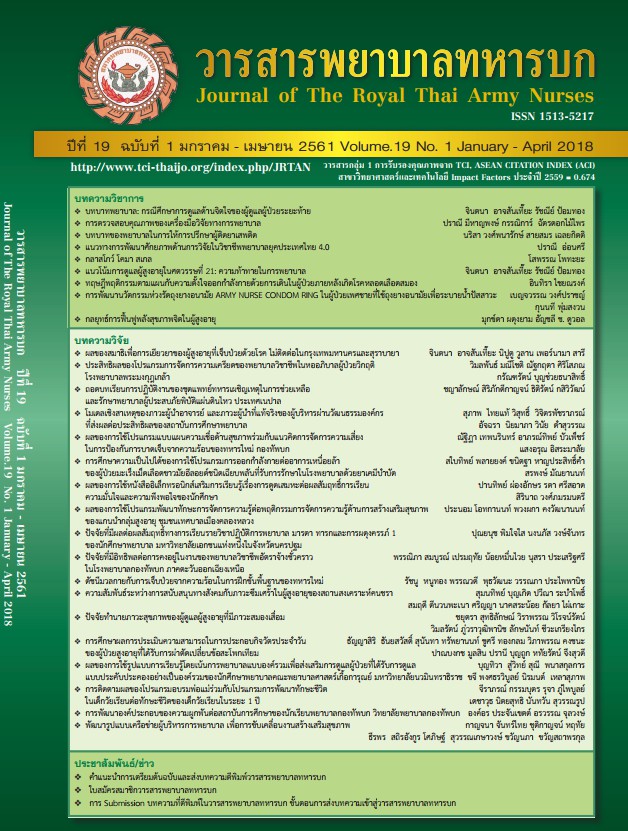ดัชนีมวลกายกับการเจ็บป่วยจากความร้อนในการฝึกขั้นพื้นฐานของทหารใหม่
Abstract
การเจ็บป่วยจากความร้อนเกิดจากการสะสมของความร้อนในร่างกายมากเกินไปจนเกิดอันตรายที่ร้ายแรงจนถึงพิการและตายได้ การตรวจคัดกรองและตรวจพบเร็วมีความสำคัญมาก การวิจัยครั้งนี้เป็นการศึกษาความสัมพันธ์ระหว่างดัชนีมวลกายกับการมีอาการนำหรือมีอาการเจ็บป่วยจากความร้อน ในการฝึกขั้นพื้นฐานของทหารใหม่ เก็บรวบรวมข้อมูลจาก ผู้ที่เข้าเกณฑ์ทหารในหน่วยทหารกองทัพบกทั่วประเทศไทย ที่เข้ารับการฝึกในผลัด 1/2556 ทุกรายที่มีข้อมูลที่ต้องการศึกษา จำนวน 809 รายโดยใช้แบบบันทึกข้อมูลส่วนบุคคล แบบบันทึกการมีอาการสะสมความร้อนในร่างกาย จากข้อมูลการคัดกรองและเฝ้าระวังรายวันระหว่างการฝึก วิเคราะห์ข้อมูลโดย การแจกแจงความถี่ ร้อยละ และหาความสัมพันธ์ด้วยสถิติ Incidence rate ratio (IRR) ผลการวิจัยพบว่า เมื่อเทียบกับดัชนีมวลกายปกติ (18.5-22.9 กก./ม2) ทหารที่มีภาวะอ้วนระดับ1 (ดัชนีมวลกาย 23.0-24.9กก./ม2) ภาวะอ้วนระดับ 2 (ดัชนีมวลกาย 25.0-29.9 กก./ม2) และภาวะอ้วนระดับ 3 (ดัชนีมวลกาย ≥30.0 กก./ม2) มีโอกาสเกิดน้ำหนักลดต่อวันมากกว่า เป็น 1.31, 1.45 และ1.56 เท่า ตามลำดับ และมีโอกาสเกิด ปัสสาวะสีเข้มมากกว่า เป็น 1.26, 1.64 และ 1.77 เท่าตามลำดับ ทหารที่ผอม (ดัชนีมวลกาย< 18.5กก./ม2) มีโอกาสเกิดปัสสาวะสีเข้ม เป็น 1.29 เท่าอย่างมีนัยสำคัญทางสถิติ ดัชนีมวลกายก่อนเข้ารับการฝึกขั้นพื้นฐานของทหารใหม่ เป็นข้อมูลสำคัญในการคัดกรองและเฝ้าระวังการเจ็บป่วยจากความร้อน
Body Mass Index And Heat Related Illness In Basic Military Training among New Conscripts
Heat related illness is caused by too much accumulation of heat in the body, which harm to serious disability and even death. Early detection and screening are very important. This research aims to study the relationship between body mass index and heat related illness in basic military training among new conscripts. Sample is military conscription in the army military units in all parts of Thailand, who exercises on groups 1/2013 (from May to July, 2013). There are 809 cases with complete information. Data were recorded the personal information before start to training, daily screening and surveillance records during exercise as signs of heat accumulation, and signs of heat related illness. Data analysis used the distribution, frequency, percentage and incidence rate ratio (IRR). The results showed that compared to normal body mass index (18.5-22.9 kg/m2), military who were obese level 1(body mass index 23.0-24.9 kg / m2), obese level 2 (body mass index 25.0-29.9
kg / m2) and obese level 3 (body mass index ≥30.0 kg / m2) were more likely to lose their body weight per day 1.31, 1.45 and 1.56 times, respectively. They were more likely to have dark urine 1.26, 1.64 and 1.77 times, respectively. The military who had low body mass index (<18.5 kg/m2) were more likely to have dark urine. Therefore, body mass index is an important data in prevention and monitoring heat related illness in military training among new conscripts.
Downloads
Downloads
Published
How to Cite
Issue
Section
License
บทความหรือข้อคิดเห็นใดใดที่ปรากฏในวารสารพยาบาลทหารบกเป็นวรรณกรรมของผู้เขียน ซึ่งบรรณาธิการหรือสมาคมพยาบาลทหารบก ไม่จำเป็นต้องเห็นด้วย
บทความที่ได้รับการตีพิมพ์เป็นลิขสิทธิ์ของวารสารพยาบาลทหารบก
The ideas and opinions expressed in the Journal of The Royal Thai Army Nurses are those of the authors and not necessarily those
of the editor or Royal Thai Army Nurses Association.






